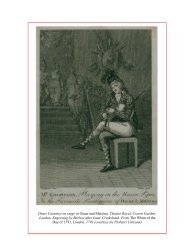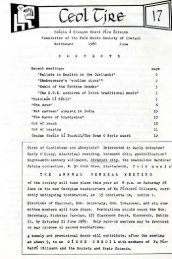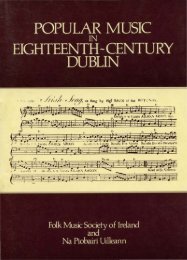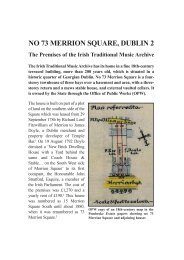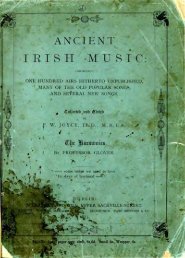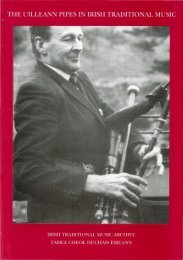Union Pipes - Irish Traditional Music Archive
Union Pipes - Irish Traditional Music Archive
Union Pipes - Irish Traditional Music Archive
You also want an ePaper? Increase the reach of your titles
YUMPU automatically turns print PDFs into web optimized ePapers that Google loves.
COUrTney’S ‘UnIOn PIPeS’ AnD The TerMInOlOgy OF IrISh BellOWS-BlOWn BAgPIPeS 50<br />
likely to have been part of his own promotion. 154 The Scottish bagpipes<br />
in question are undoubtedly to be understood as the mouthblown<br />
highland bagpipes, and the <strong>Irish</strong> bagpipes as the<br />
bellows-blown instrument, both, as seen, recently known in<br />
contemporary london. Although Scottish and <strong>Irish</strong> bagpipes had long<br />
existed in both mouth- and bellows-blown forms, this fact was unknown<br />
or ignored by writers (as distinct from artists) in contemporary<br />
england. A plethora of eighteenth- and nineteenth-century statements<br />
in print there conveys this over-simple dichotomy of Scottish bagpipes<br />
being mouth-blown and <strong>Irish</strong> bellows-blown. 155 What elements<br />
of each bagpipe are being united? In organological terms, this explanation<br />
does not make sense. The Scottish pipes and <strong>Irish</strong> pipes, as we<br />
know them from documentary evidence and surviving sets, are each<br />
separate linear descendants of earlier Scottish and <strong>Irish</strong> pipes respectively,<br />
and each exhibit only separately localised forms of the elements<br />
of their continental ancestors. each type of bagpipe had<br />
154<br />
As has been seen, Courtney’s 1793 Dublin management often advertised his<br />
instrument as ‘bagpipes’ but he himself, personally seeking engagements, refers<br />
to them as ‘union pipes’.<br />
155<br />
See for example Pennant 1772: 178: ‘Bag-pipes... The oldest are played with<br />
the mouth, the loudest and most ear-piercing of any wind musick; the other,<br />
played with the fingers only, are of <strong>Irish</strong> origin...’; and Jones 1794: 116: ‘we<br />
have reason to believe that the Britons blew it [the Bagpipes] with the mouth,<br />
instead of the bellows, like the <strong>Irish</strong> pipes’. This perceived distinction between<br />
the two kinds of bagpipes is also reflected in the advertisements of those english<br />
musical-instrument sellers of the second half of the eighteenth century who<br />
advertise ‘Bagpipes, Scotch and <strong>Irish</strong>’ (see note 40 above), and must have been<br />
supported by the contemporary exploits of highland pipers in the British army.<br />
Queen Victoria much later made the same distinction, and preferred the Scottish:<br />
‘Friday August 10 [1849]... The <strong>Irish</strong> pipe is very different from the Scotch; it<br />
is very weak and they don’t blow into it, but merely have a small bellows which<br />
they move with the arm. – Queen Victoria, Leaves from the Journal of Our Life,<br />
london, 1868: 184, quoted in An Píobaire vol. 3, no 7 (July 1991, contributed<br />
by Seán Donnelly). The more significant difference at any rate is the extended<br />
musical range of the <strong>Irish</strong> chanter rather than its air source.



